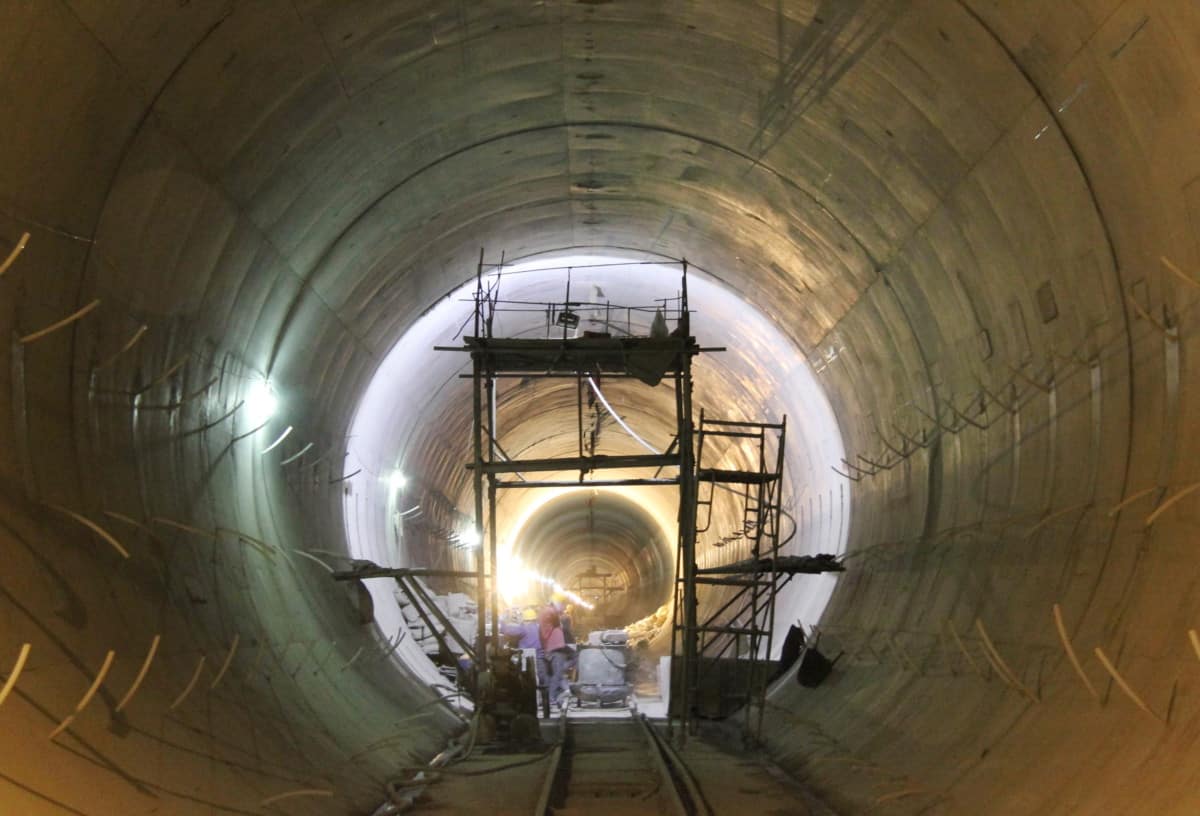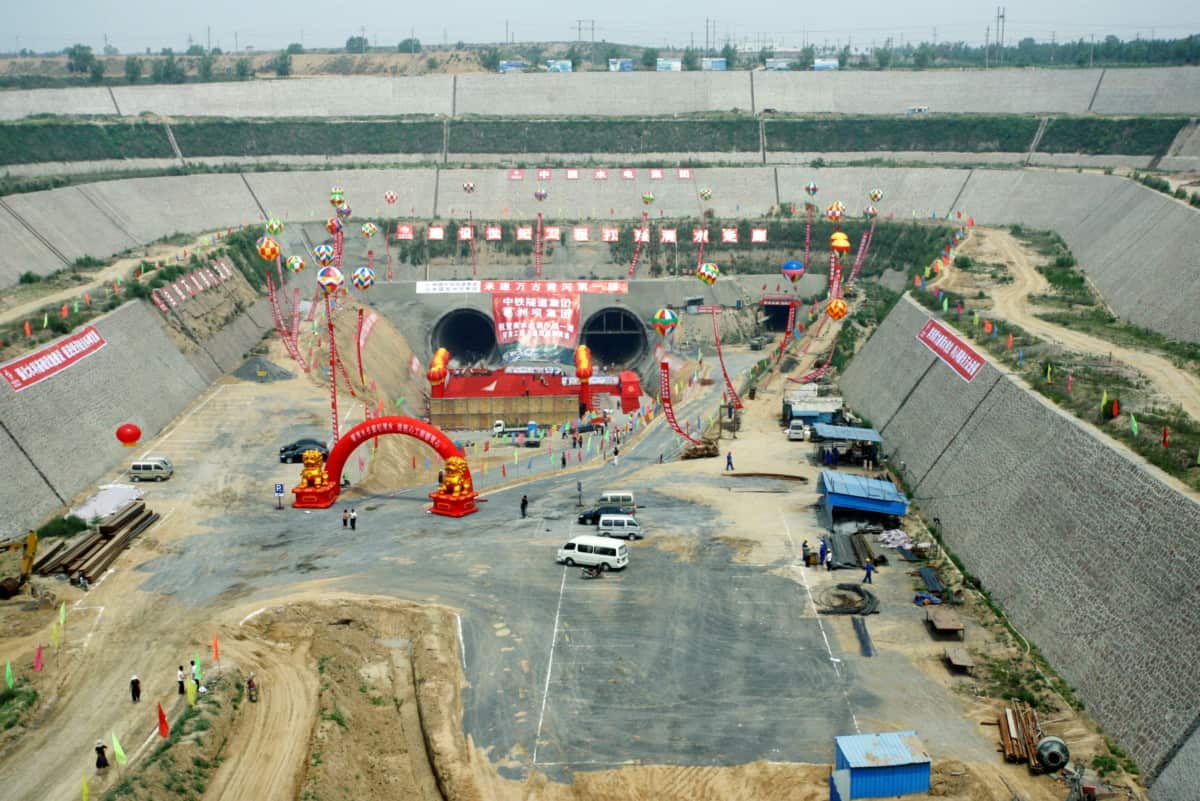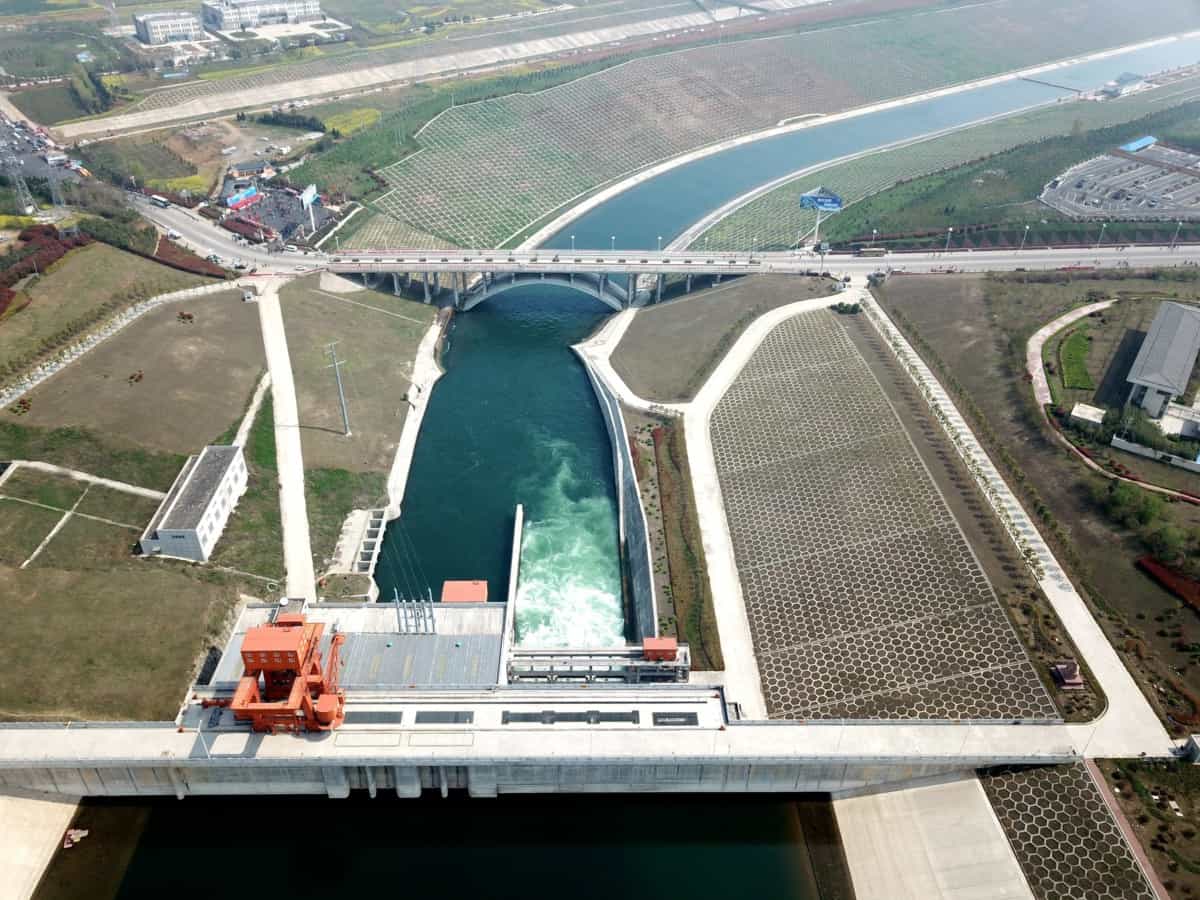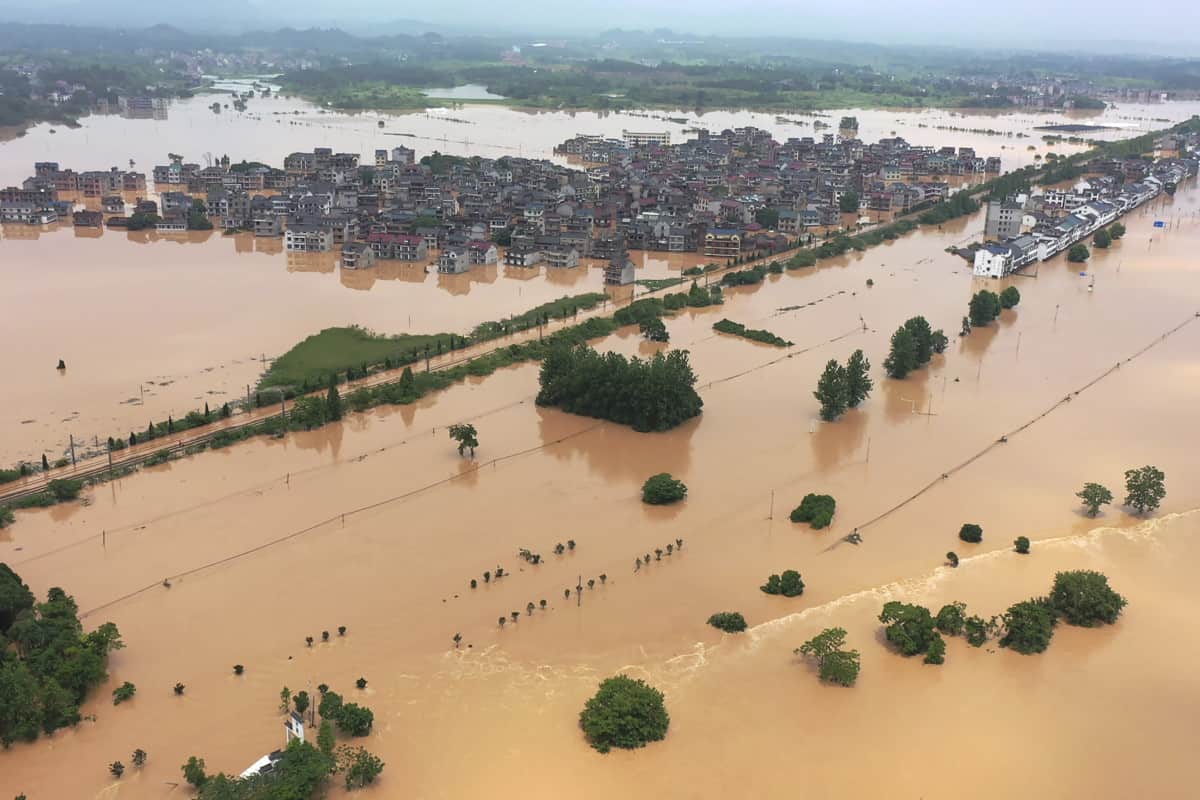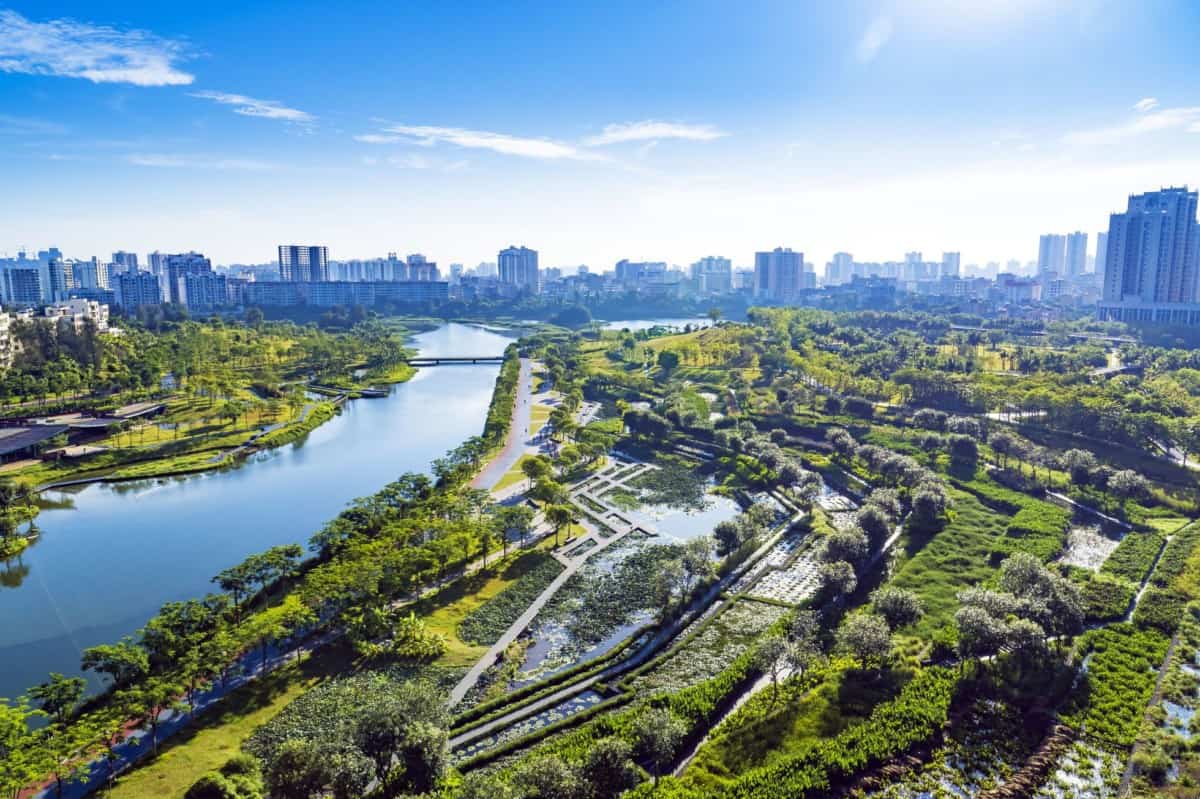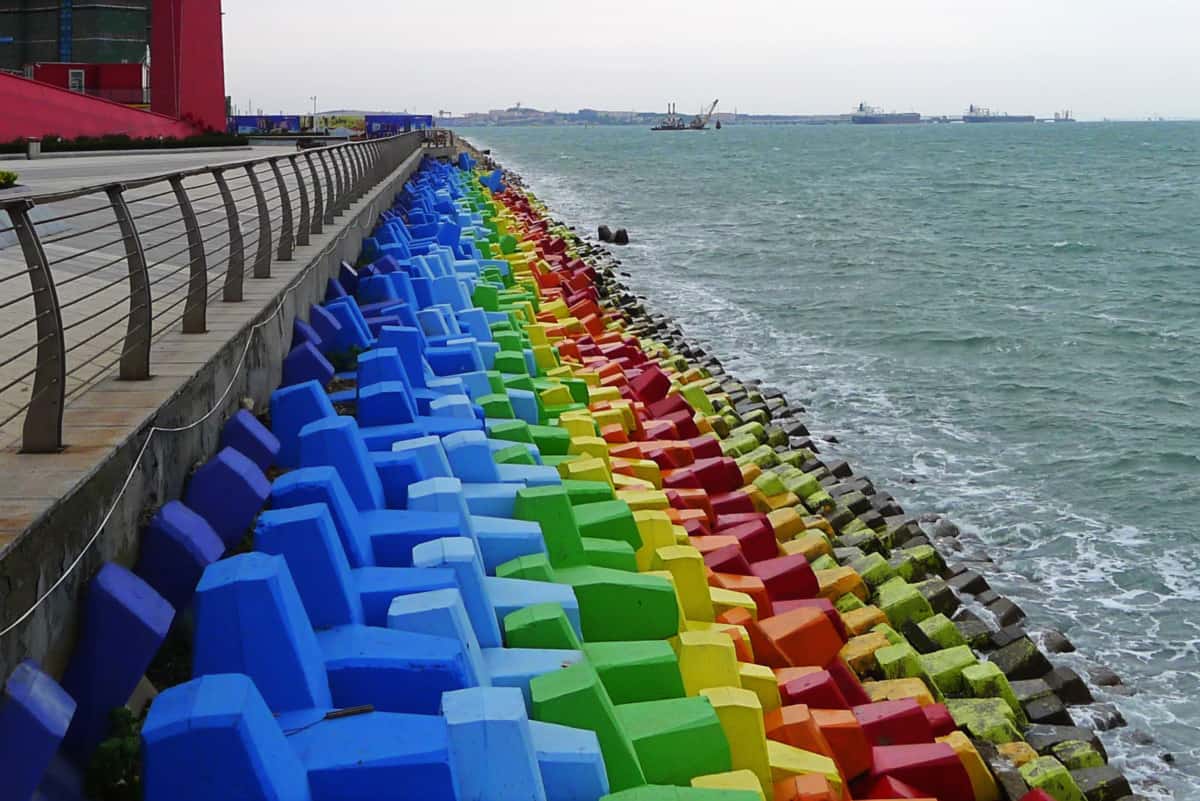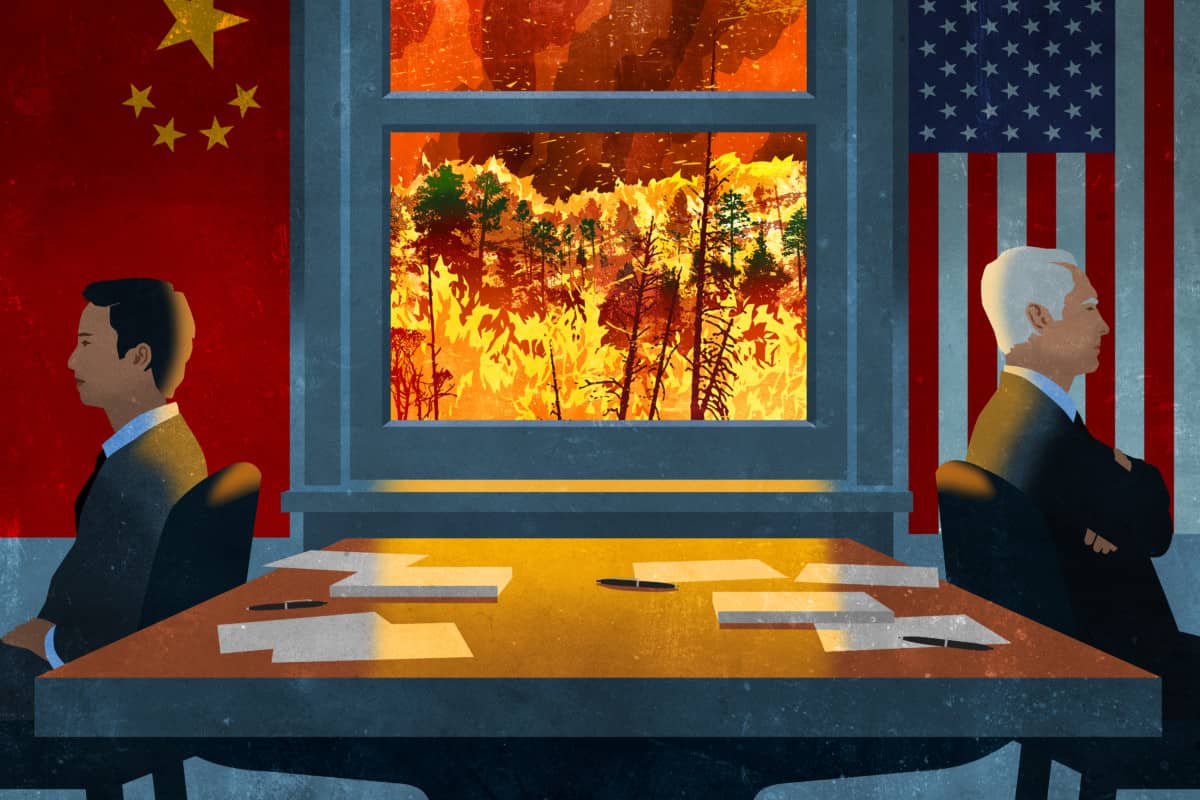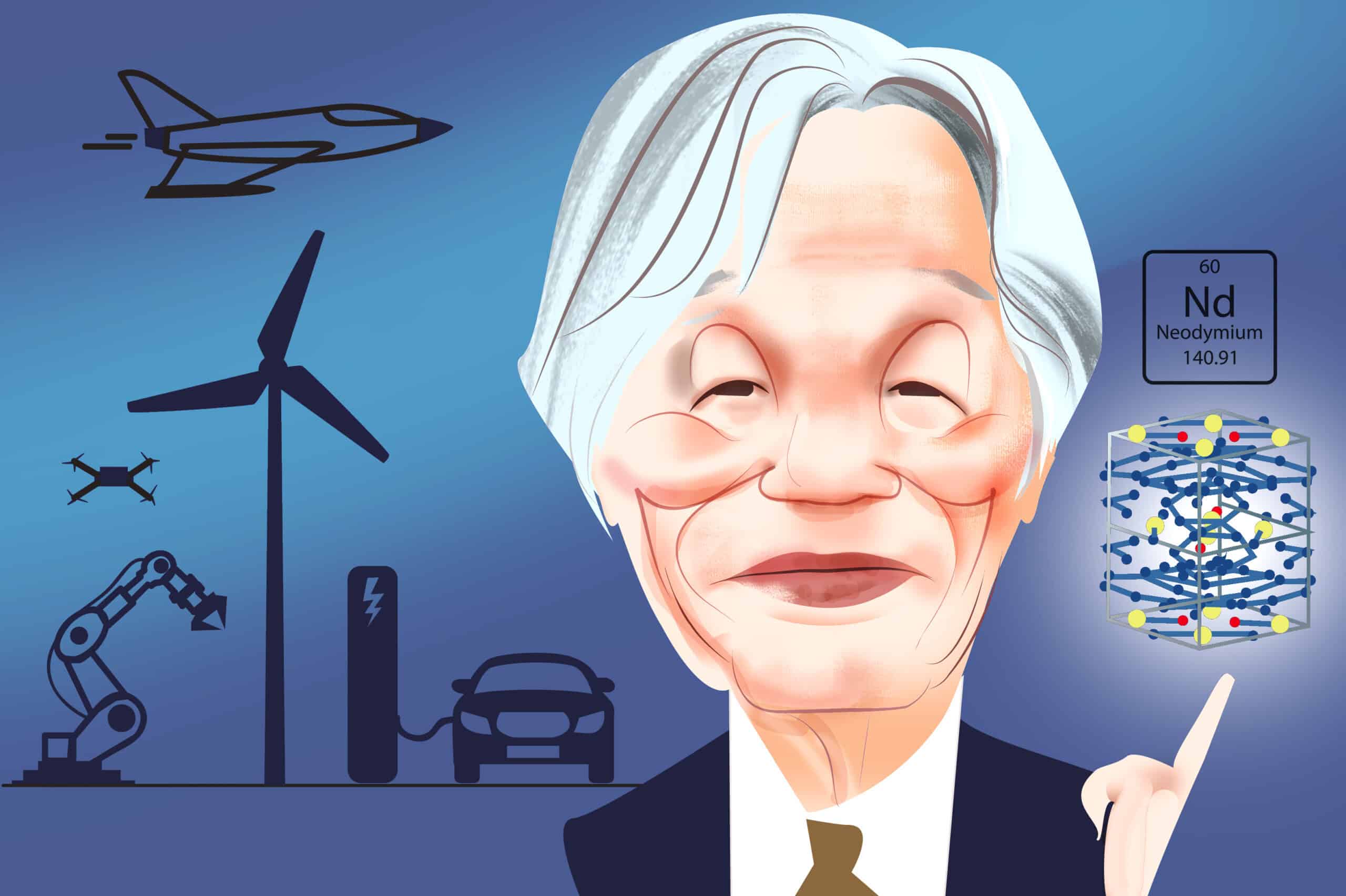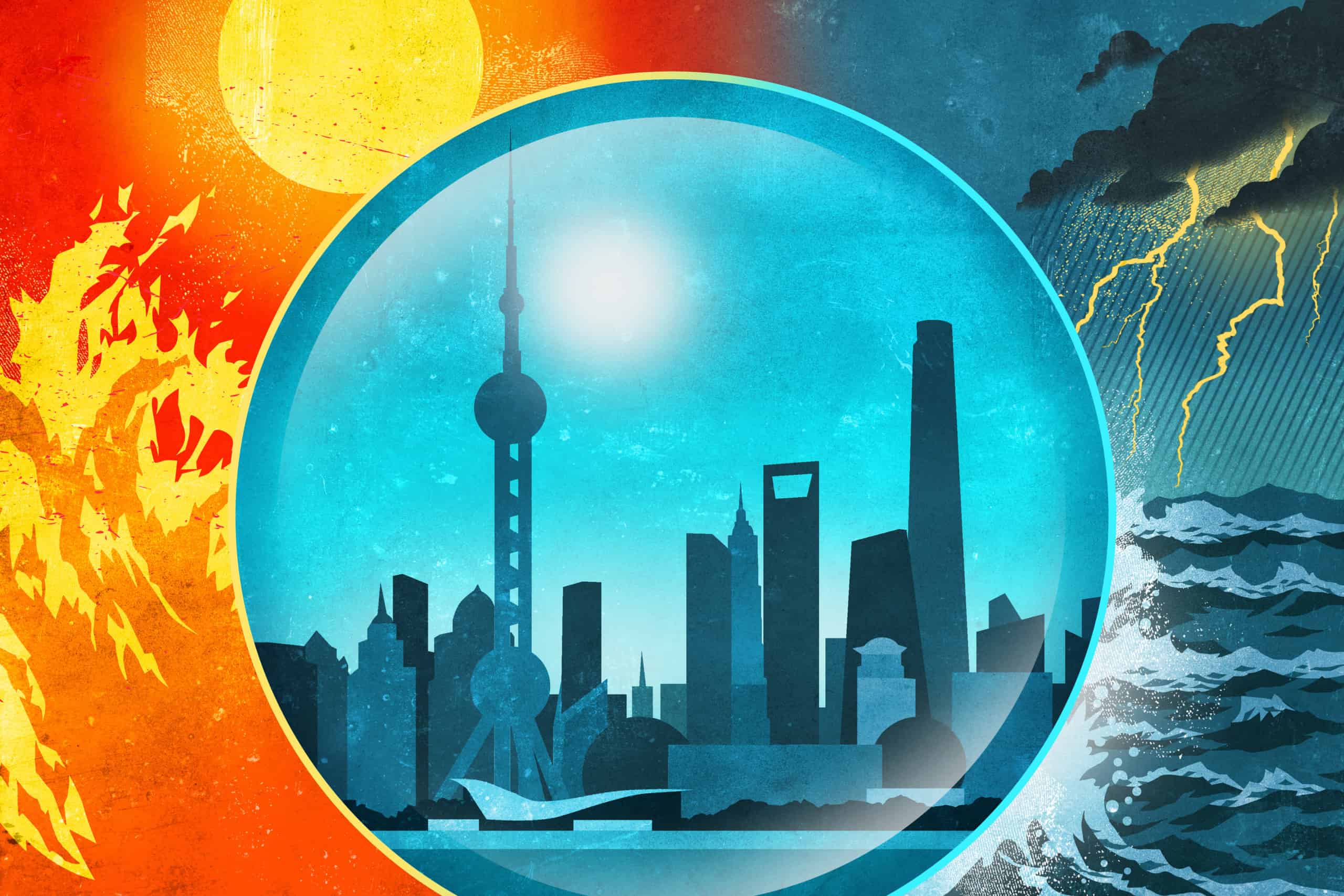
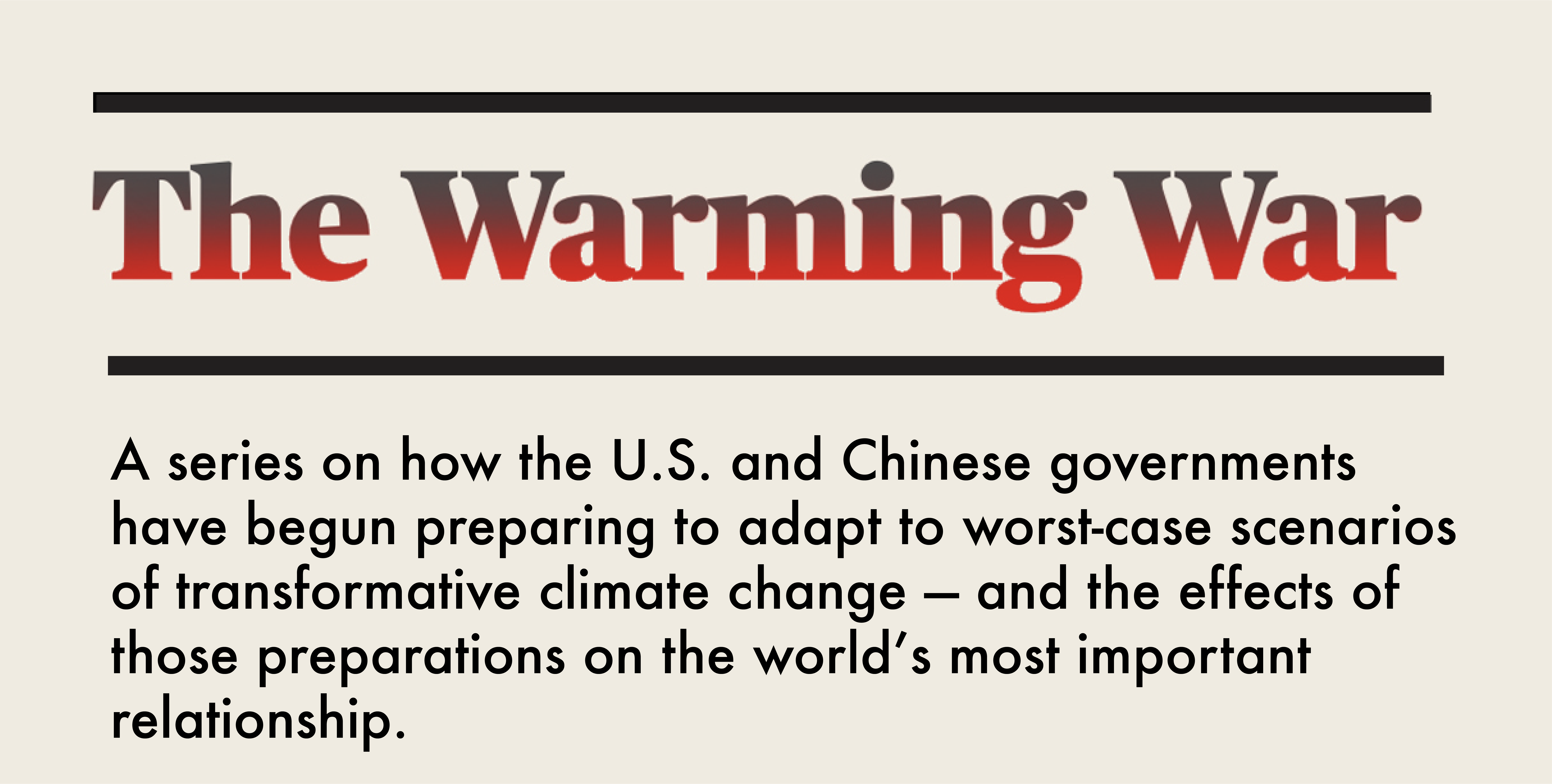 |
|
| More in this series: | |
| The Diplomatic Deadlock | 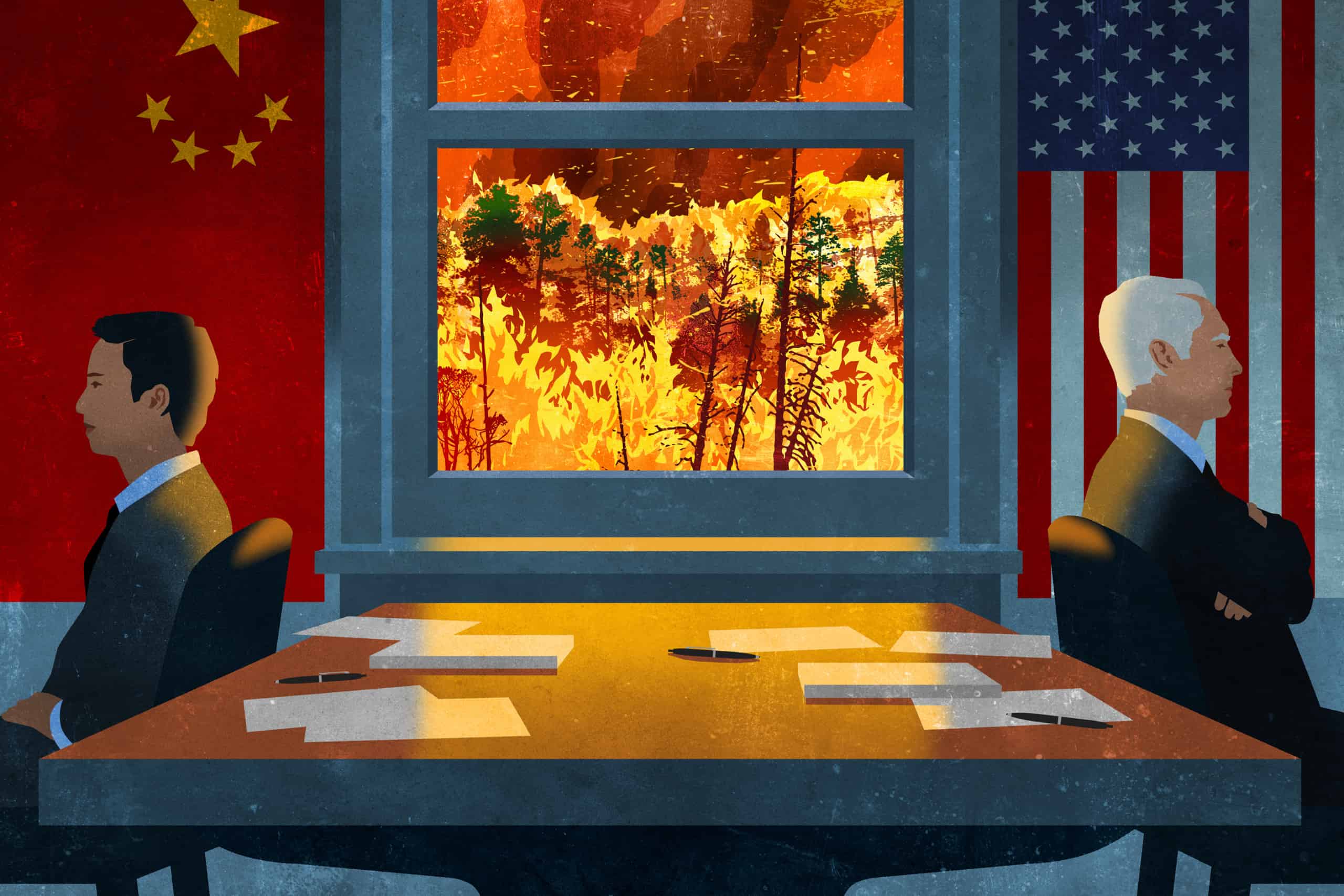 |
| Pole Position |  |
| The Ocean Edge |  |
| Climate Consensus |  |
| Climate Changers |  |
On an August day last year, Xi Jinping visited Saihanba National Forest Park to inspect the trees and flowers.
Spanning nearly 200,000 acres northwest of Beijing, the old imperial hunting ground turned to desert in the 19th century amidst deforestation and overuse. With no trees left to catch the wind, violent sandstorms rolled in from Inner Mongolia, filling Beijing’s air with choking sediment. But in 1962, Chinese authorities began a multi-decade project to restore the region into a “Great Green Wall” defending the capital.
It worked. Today, Saihanba is the world’s largest planted forest. During his visit, Xi praised the Communist Party’s four decades of “struggle,” which he said had transformed a wasteland where “yellow sand covered up the sky” into “a source of rivers, a homeland of clouds, a world of flowers, a sea of forests and a paradise for birds.” Saihanba, Xi said approvingly, is a “model example in China’s pursuit of ecological progress.”
Under Xi Jinping, China hopes to turbo-charge that progress by turning scattered environmental renewal projects like Saihanba into a Party-led mass mobilization effort. Xi is also pushing to develop “ecological civilization,” a slogan that precedes his rise to power, into a state ideology that will be the cornerstone of his legacy.
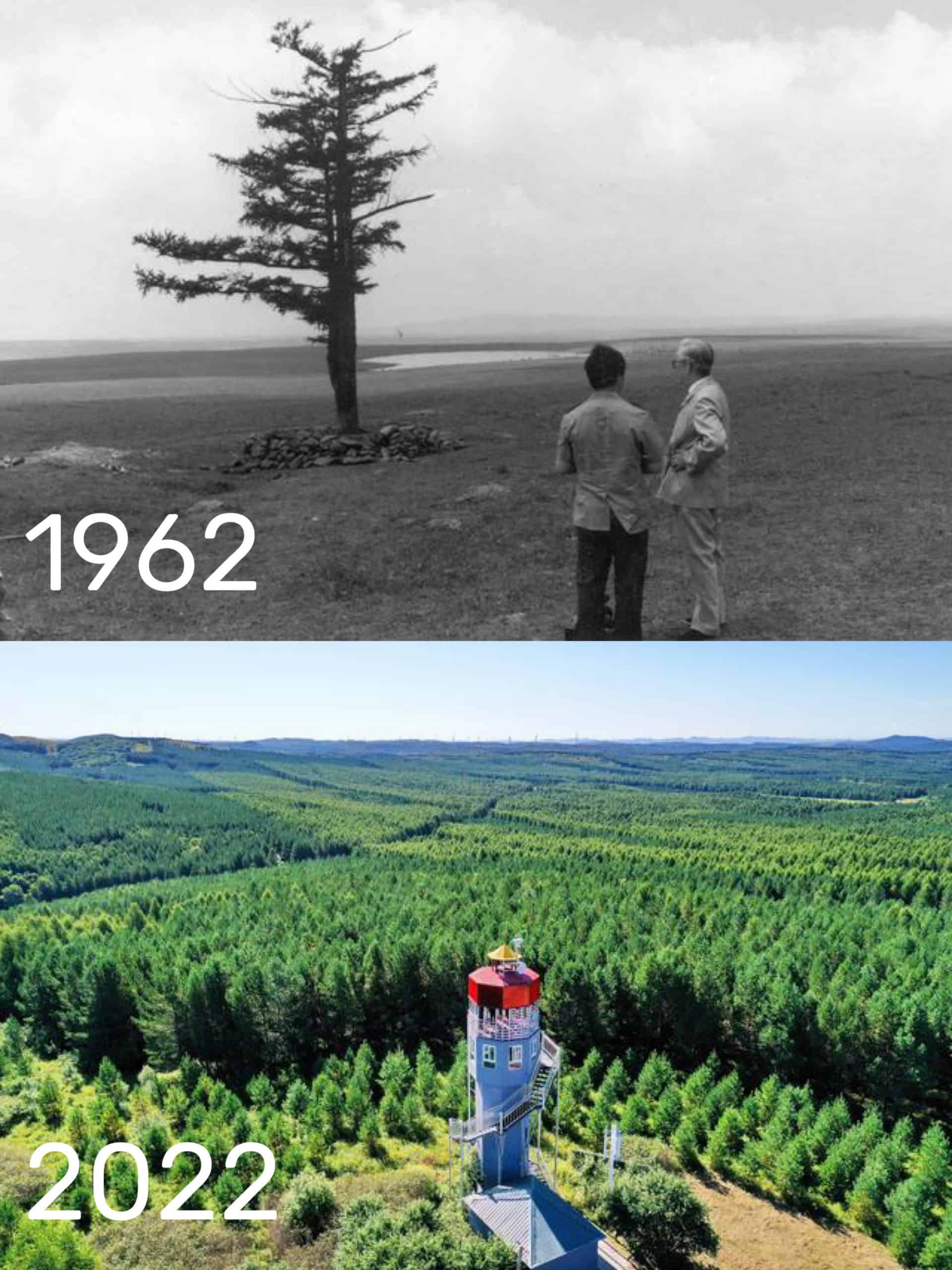
“Xi Jinping Thought on Ecological Civilization” asserts that ecological civilization will replace “industrial civilization” as the next stage of development in human history — and in China’s long march toward national rejuvenation. As the People’s Daily noted in a series of essays about Xi’s visit to the park, Saihanba represents a triumph over environmental degradation that “proves the superiority of the socialist system.” The forest is “visually green,” it observed, but “its spirit is red.”
Officials across China have taken note. After Xi’s first visit to Saihanba, they planted new forests the size of Belgium and the Netherlands combined.
Curiously, while Xi framed his visit to Saihanba as part of his campaign to “build a beautiful China,” he didn’t mention the perils of climate change, even though combating climate-driven desertification is a primary goal of the country’s forestry programs.

The Chinese government has taken to using “ecology” as a euphemism for climate adaptation, emphasizing the Communist Party’s ability to transform nature for the better while downplaying the grave risks of climate worst-case scenarios.
This may be because the country’s leaders are not as concerned about the effects of climate change as leaders in the West. Or, as many climate security experts suspect, it could be because they don’t want the public to realize how concerned they are.
“Framing climate as an existential threat raises the urgency of the issue,” says Commander Andrea H. Cameron of the U.S. Naval War College, who advises the Office of the Secretary of Defense for Policy on climate security. “On the other hand, by associating climate with threat, you also highlight your own vulnerabilities. I suspect Chinese officials are intentionally leaving it out of their vernacular.”1The views expressed are those of Andrea Cameron and do not reflect the official policy or position of the Office of the Secretary of Defense, the U.S. Navy, or the U.S. Government.
Indeed, under Xi Jinping, China has undertaken thousands of projects — across industries and in every part of the country — that are clearly designed to protect the country against extreme climate change.
The Chinese government is not holding out hope for a technological or diplomatic breakthrough. While it still aims to peak emissions before 2030 and achieve carbon neutrality by 2060, the National Strategy for Climate Adaptation released last month explicitly states that “the warming of the climate system is expected to continue through the middle of this century,” if not beyond, and “the adverse effects and risks of climate change will continue to intensify.”
These risks will keep mounting “even after the world achieves carbon peaking and carbon neutrality.” Neither of those goals seems likely to be met anytime soon, with global climate diplomacy stalled and Chinese and Indian emissions still rising.
In other words, China believes it has no alternative. It must adapt and find a way to thrive in a warming world. And Xi’s embrace of the “Saihanba spirit” illustrates how China is thinking about the warming world very differently from most Western countries.
While much of the West is determined to mitigate the effects of climate change by cutting down on carbon emissions, Beijing has chosen to tap its engineering prowess to favor adaptation. That is because sharp cuts in its own emissions could significantly hamper economic development and its powerful position as the world’s factory floor. So rather than prioritize mitigation, it is pressing ahead with adaptation, arguing that as a developing nation it is justified in taking this position.
“Deeply embedded in the Chinese state’s thinking about ‘ecological civilization’ is this idea that you can constantly be technocratic and engineer your way out of every single challenge,” says Yifei Li, assistant professor of sociology at NYU Shanghai and co-author of the book China Goes Green: Coercive Environmentalism for a Troubled Planet.
These principles are enshrined in Chinese policy doctrine, which pledged a decade ago to “integrate the requirements of climate change adaptation into the whole process of China’s economic and social development.” Top-level Chinese politicians and scientists have said repeatedly that adaptation is a “more realistic and urgent priority” for China than mitigation, the expensive and difficult task of cutting emissions.
There is no question that China’s leaders think that climate change is a big deal. But at the end of the day, they are really focused on China, not on the global problem.
Ken Lieberthal, former Asia director on the National Security Council in the Clinton administration
“They will take some steps to reduce their greenhouse gas emissions, but they can only do so much at a reasonable cost,” says Dennis Blair, who led U.S. Pacific Command before serving as U.S. Director of National Intelligence in the Obama administration. “They need to adapt for the rest.”
The efforts China is taking to adapt to climate change are unprecedented in speed and sweeping in scope. The country is constructing the largest water transfer system in human history; expanding and raising nearly 6,000 miles of sea walls along its coasts; building a strategic grain reserve larger than the rest of the world’s combined; carving wetland flood basins in the centers of its largest cities; restoring coastal wetlands to act as buffers against storms; and relocating hundreds of thousands of “ecological migrants” in low-lying areas.
If all these efforts stay on track, China thinks it can establish a “basically climate-resilient society” by 2035, in which “the risk of major climate-related disasters will be effectively prevented and controlled,” according to the National Strategy. Thousands of pages of planning documents, statements from senior officials, and essays by prominent scholars analyzed by The Wire echo this belief.
But Ken Lieberthal, former Asia director on the National Security Council in the Clinton administration and senior fellow emeritus at the Brookings Institution, fears that if these measures succeed, they could have unintended consequences.
“There is no question that China’s leaders think that climate change is a big deal,” Lieberthal says. “But at the end of the day, they are really focused on China, not on the global problem.”
China’s decision to prioritize climate adaptation will have sweeping implications for geopolitics and the planet. For now, China appears committed to its pledges to peak emissions before 2030 and achieve carbon neutrality by 2060. But if China can successfully position itself to survive and thrive in a rapidly warming world by the mid-2030s, as it plans to do, the less pressure Beijing will feel to make painful emissions cuts — and the less other countries will trust its promises. If other major emitters follow China’s example and decide to prioritize adaptation, it could become even harder to reach an emissions deal that holds global warming below 2 degrees.
Many of the steps China is taking to build resilience to climate change, from weather modification to global fishing to satellite monitoring, have rippling effects that extend far beyond China’s borders. China may see its climate adaptation push as a purely internal affair and a common-sense policy to protect its national security. But does America see it that way?
“A LONG AND ARDUOUS CHALLENGE”
From a purely geographical perspective, few large countries are more vulnerable to extreme climate change than China. Climate models show that the world’s most populous country is particularly vulnerable to floods, drought and sea level rise. Across the North China Plain, nearly a million square miles of land are already experiencing water stress. In southern and central China, annual torrential floods now push some of the world’s largest dams close to failure, threatening China’s agricultural breadbasket and its core industrial base.
“China’s government needs to ensure reliable food supplies for a population more than four times the size of the United States, with less than half the arable land — and most of this land is at constant risk of flooding,” says Zhang Hongzhou, a research fellow at the S. Rajaratnam School of International Studies in Singapore and an expert on Chinese food policy.
A 2009 report by the U.S. National Intelligence Council concluded that China’s situation was dire. “The forthcoming water crisis” caused by climate change “may impact China’s social, economic, and political stability to a great extent,” it assessed. It also warned that “China’s coastal regions, the engine of China’s economic achievement, are highly vulnerable to storm, flood, and sea-level rise.”
The city center of Shanghai, for instance, sits only two meters above sea level and depends on seawalls to protect it from annual typhoons. As Wen Jiahong, head of the disaster risk assessment center at Shanghai Normal University, told an interviewer in 2019, Shanghai “looks like a ship, and the surrounding water is higher than the bottom of the ship.”

As early as 2007, China released its first official climate adaptation strategy, which laid out the country’s basic framework for responding to the climate challenge. The document explicitly called adaptation a “more pressing and imminent task” than mitigation, noting that it represents “a long and arduous challenge” for China.
China’s latest National Strategy for adaptation, released in June, used almost identical language to describe the primacy of adaptation. It also identifies several new climate-related challenges that China will have to manage, including “a variety of allergic and chronic diseases” and “systemic financial and economic risks.”
“China’s leaders absorbed the lesson very early that China is one of the more vulnerable countries in the world to climate change,” says Lieberthal. “That’s why they have focused so seriously on adaptation.”
To address all these risks together, Zhang Haibin, one of China’s leading climate scientists, worked with other scientists, urban planners, engineers, and security analysts to persuade the State Council in 2012 to adopt an entirely new, holistic concept that it called “ecological security” (shengtai anquan). Zhang, for instance, has presented data that predicts climate change could threaten military assets, jeopardize critical infrastructure such as nuclear power plants, and even lead to social unrest.
“Securitizing the ‘ecology’ issue in official documents makes clear that climate change is of the utmost importance to the regime,” says Yanzhong Huang, a senior fellow at the Council on Foreign Relations and an expert on Chinese environmental and health policy. “It has created new incentives to mobilize resources across the whole government.”
Yet, while scholarly reports and technical planning documents drill down on “ecological security,” propaganda and speeches by top officials have communicated a more hopeful vision to the public.
“Chinese state media hardly ever discuss the climate worst-case scenario,” says Huang at the Council on Foreign Relations. “It’s a completely different story from COVID-19. The authorities do not want panic in the public sphere.”
“Ecological civilization” has been framed as environmentalism with Chinese characteristics. It was added to the National Party Constitution in 2012, and Xi has appropriated the slogan as his own idea, envisioning a model of “people-centered development” based on “harmony between man and nature” (tianren heyi).
Ecological civilization is all about leveraging natural systems to create sustainable economic growth, clean air, and green spaces. But unlike Western concepts of environmentalism that emphasize conservation and protection of “untouched” nature, ecological civilization places its faith in engineering. If industrialization in the past has damaged and destroyed ecosystems, then human beings — with ingenuity, dedication, and wise socialist leadership — should simply rebuild them.
Experts say understanding the Chinese state’s distinctive concept of environmentalism helps explain why it is taking a different political approach to climate change than the United States. Propaganda films celebrating ecological civilization, for instance, exhort local officials to “build” beautiful nature and to solve problems like floods and waste management, just as they would design airports, high-speed rail lines, and other infrastructure. To “protect important ecosystems” currently at risk, the National Strategy even recommends using “artificial weather modification.”
“China is an infrastructure building country,” says Blair. “There’s a sense that they can engineer their way out of climate change. They accept that some impacts are going to happen, and so they are trying to be smart about dealing with them, whether by building sea walls or moving factories.”
“A CLIMATE-ADAPTED SOCIETY”
While developed countries agonize over the emissions issue, China’s primary focus remains on adaptation.
China’s new and updated climate adaptation strategy includes a dizzying number of directives and targets, and it sets out a breathtakingly ambitious goal: to “build a basically climate-adapted society” by 2035 in which “the risk of major climate-related disasters is effectively prevented and controlled.”
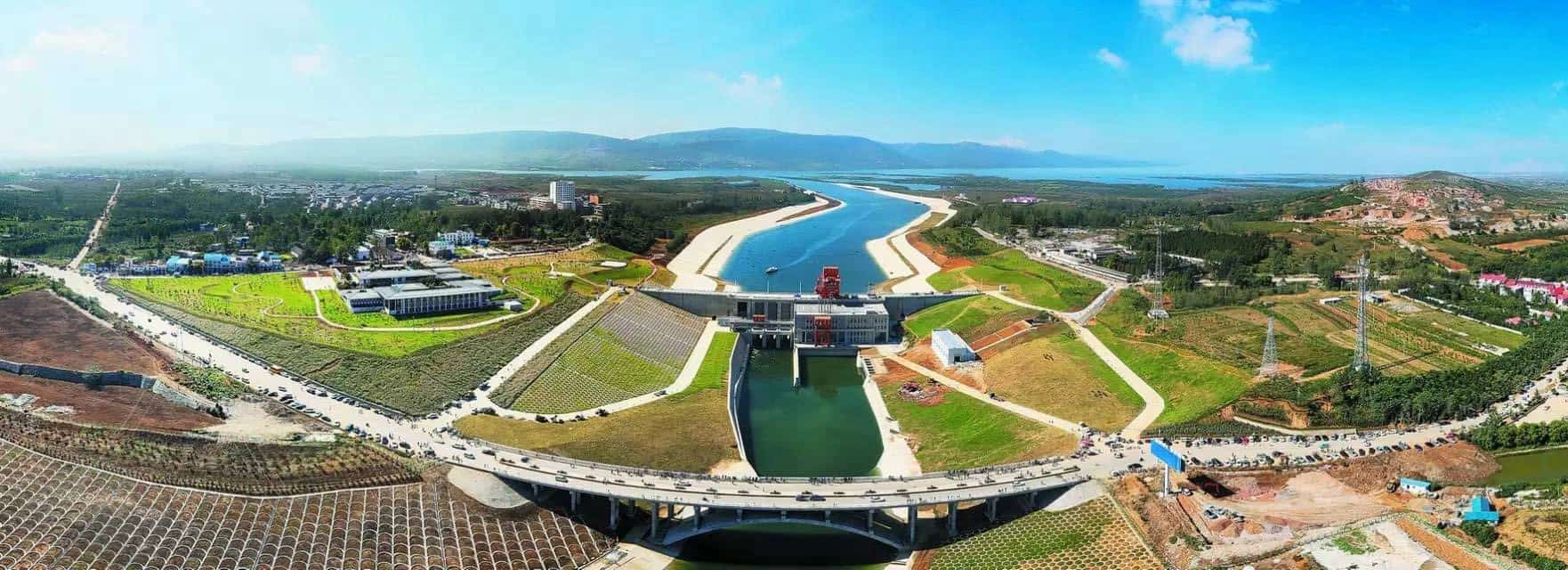
Credit: Nsbdgc via Wikimedia Commons
Water management is a cornerstone of the strategy. By 2035, the Chinese government plans to deploy a “digital, networked, and intelligent water conservancy system” that uses artificial intelligence to predict water-related disasters a month in advance and move vast quantities of water across the country to balance out the impact.
When completed, China’s South-North Water Transfer Project will be the largest hydraulic engineering feat in human history. It will connect China’s four main river systems — the Yangtze, Yellow, Huaihe and Haihe — through eastern, central, and western canal systems, redirecting water from the flood-prone south to the arid north.
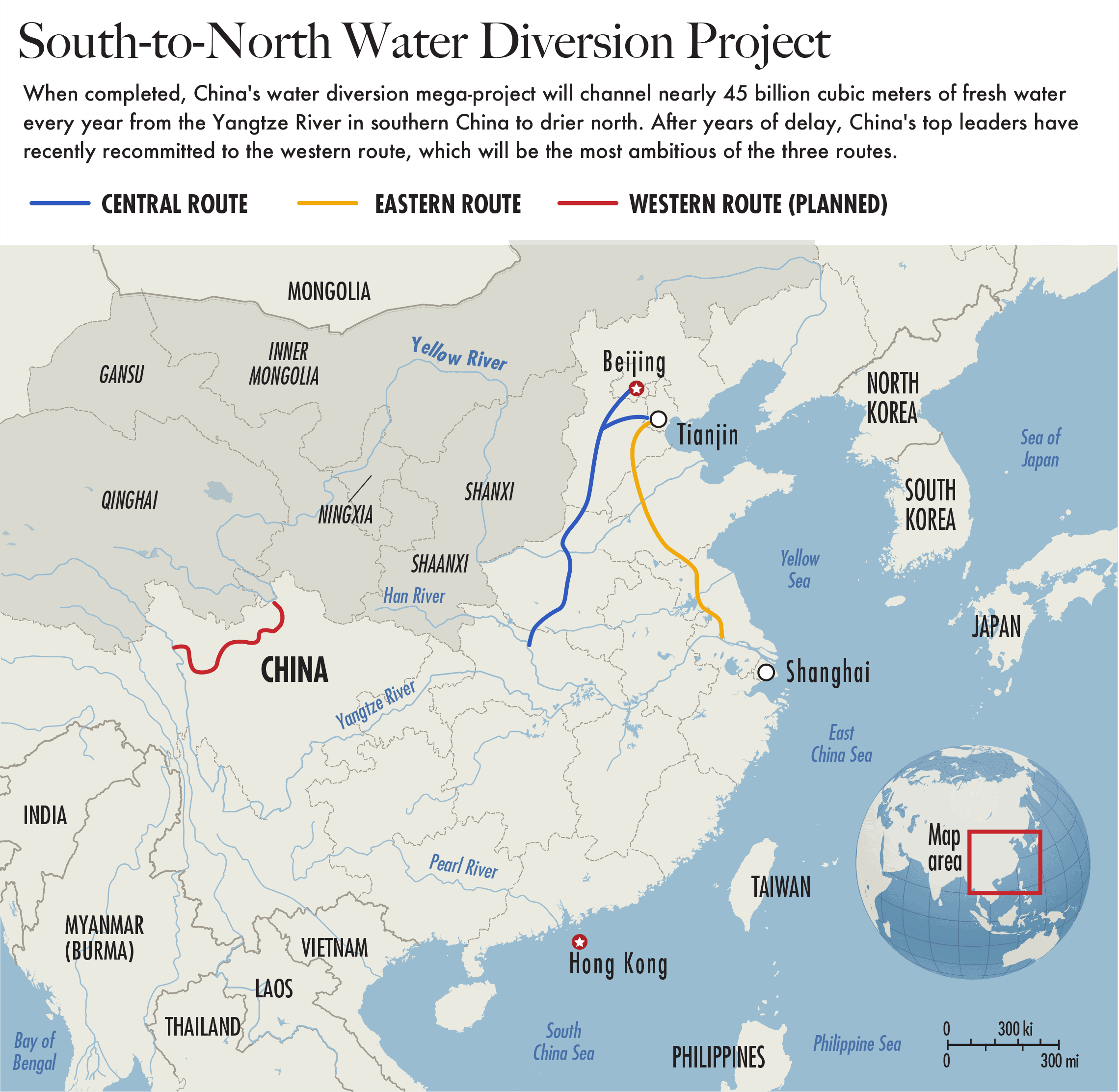
The first two routes are already operational. In 2019 Premier Li Keqiang ordered work to begin on the western one, the most ambitious and controversial of the three. The cost is unknown, but likely runs in the hundreds of billions of dollars. If the project reaches full capacity, it will move approximately 44.8 billion cubic meters of water northward each year, meeting the needs of almost half a billion people by 2050.
To further address potential water shortages, China also recently announced plans to build new desalination facilities that can produce 2.9 million tons of fresh water a day in northern China. Xi Jinping has personally created a national “sponge city” program to make China’s urban areas more resilient to floods and droughts by building a network of vast parks that can act as water catchment areas in emergencies. By 2030, 70 percent of Chinese cities must be able to collect and recycle 80 percent of their rainwater.
Efforts of this scale make sense only if China is bracing for the most extreme warming scenarios.
“Most of this water transfer infrastructure would be needed for adaptation to 2 to 4 degrees celsius of warming, and doesn’t make much sense otherwise,” says Scott Moore, an expert on Chinese water and technology policy at the University of Pennsylvania. “From water diversion to storage dams, they are building resilience to an extreme amount of flooding and drought.”
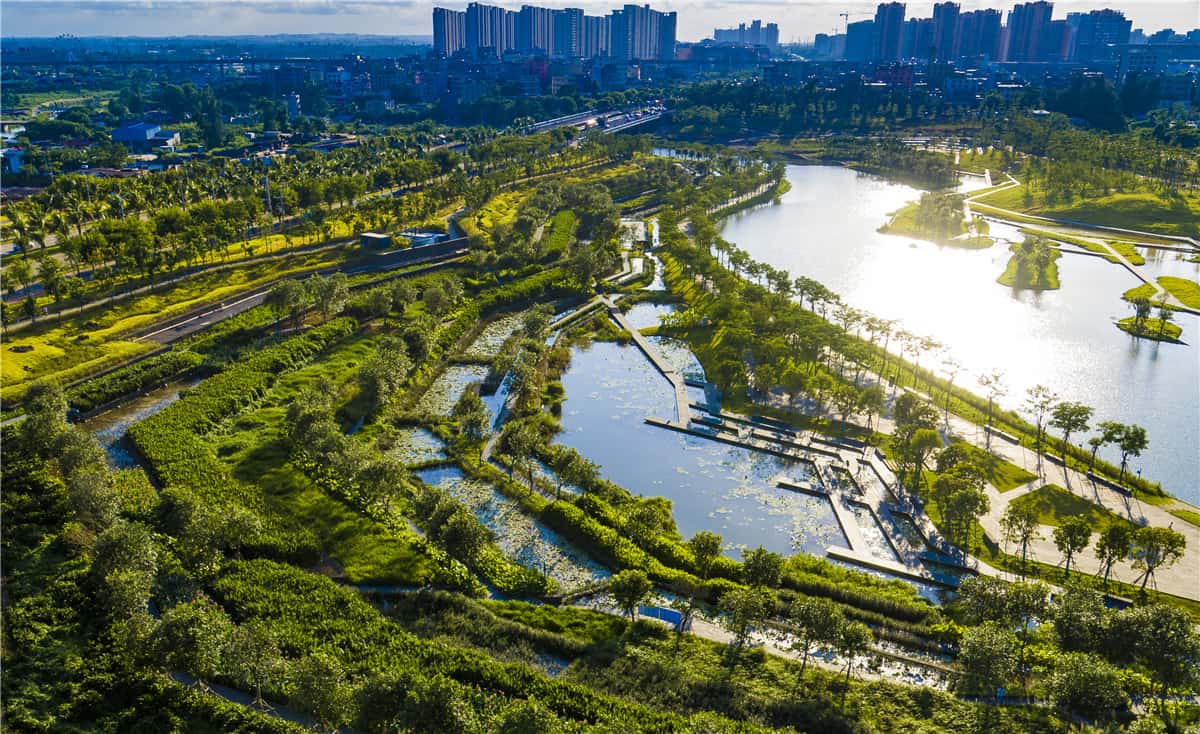
As a coastal country, China is also prepared to adapt to whatever sea level rise climate change creates.
The 2007 Climate Change Programme ordered local officials to “raise [the] protection standard for coastal cities and major projects” to cope with the risk of sea level rise. As Sang Baoliang, deputy director of the Shanghai Flood Control Headquarters, told an interviewer matter-of-factly in 2009, “If the research determines that indeed the sea level will rise further, then we will need to build the walls higher.”
In 2017, two leading central government agencies went further, adopting a National Seawall Construction Plan. This scheme committed to building 430 kilometers of new seawalls, raising thousands of kilometers of existing coastal protections, and creating a new framework for monitoring and maintenance. The goal, it stated, was to “basically guarantee the tide-proof safety of important cities and important economic development areas seriously threatened by typhoon storm surges.” More recently, China has teamed up with the Dutch-led Global Commission on Adaptation to import the best foreign technology for building flood barriers and sea walls.
China has applied the same logic to food security. According to the country’s National Strategy, to “establish a food security guarantee system that can adapt to climate change,” China will need to “achieve breakthroughs in disruptive technologies for agricultural adaptation.”
In a major speech this March, Xi called for a massive expansion of China’s grain stockpile, as well as research into genetically modified crops and artificial proteins like lab-grown meat. “We should shift our focus from farmland only,” Xi said. “By developing biological science, biotechnology, and bio-industries, we can obtain calories and protein from plants, animals, and microorganisms.” These measures may sound strange to ordinary Chinese households today, but they will ensure that China has access to protein in the future if global food supplies ever face a sudden climate-related shock.
China is also embracing a data-driven approach to analyzing and organizing its adaptation goals. The Ministry of Ecology and Environment (MEE) still lags behind the United States’s National Oceanic and Atmospheric Administration (NOAA) in terms of measuring and predicting weather patterns. But to catch up, the MEE is building a national database based on a vast network of sensors to monitor real-time weather data and to guide its adaptation strategy. It is also working with Belt and Road countries to establish a global satellite monitoring system.
Finally, China’s National Strategy sets out to make Chinese society more resilient to climate-induced disasters. It calls this “stopping the transmission of climate risks from natural ecosystems to economic and social systems.”
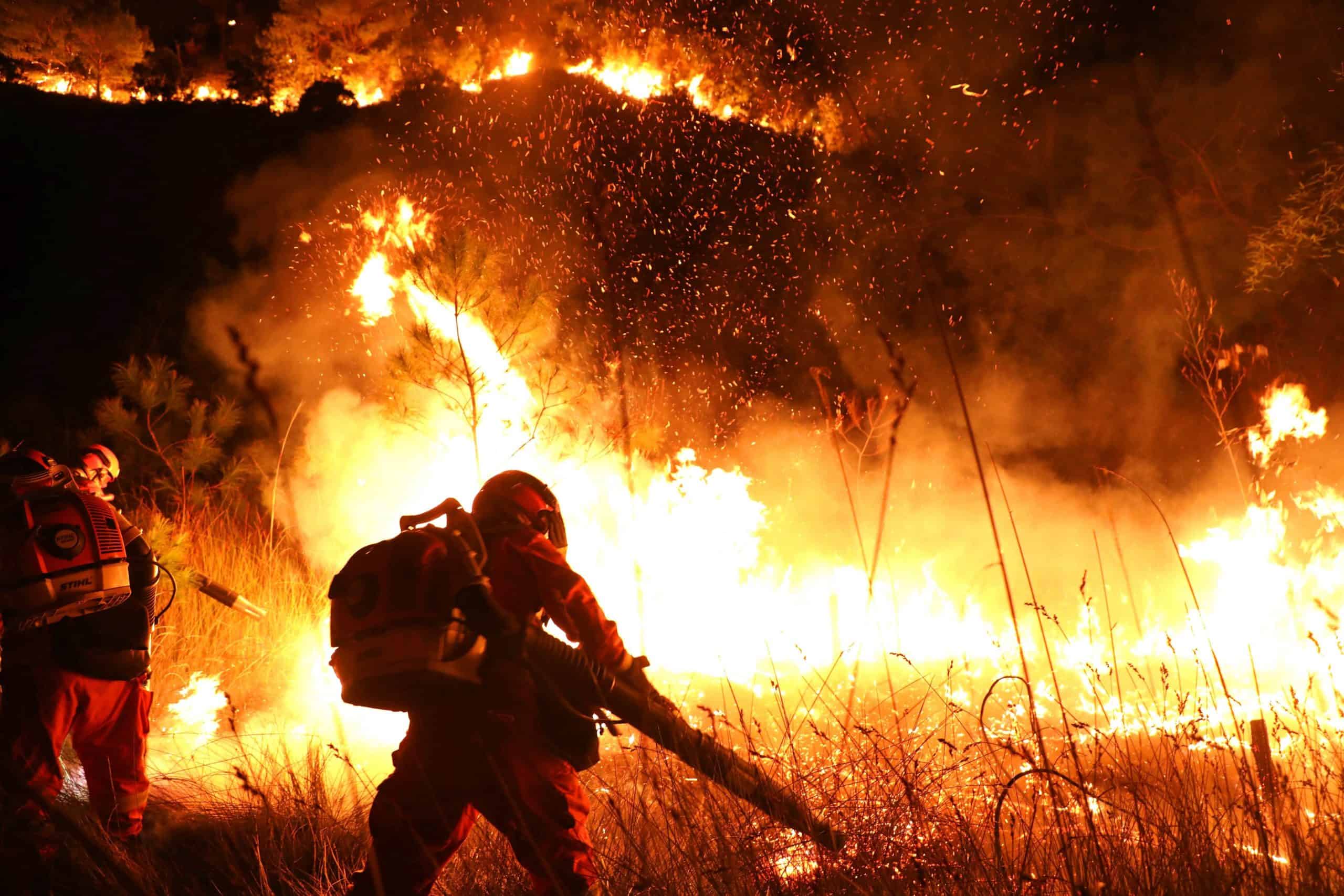
The document hints that China may soon be ready to start educating the public and preparing it psychologically for the climate disruption to come. But first, it will establish a dazzling suite of resources for rapid response to natural disasters like floods and forest fires and establish a national mental health service system to help distressed people learn to live with extreme weather and climate events.
CLIMATE CHANGE & GEOPOLITICS
The fact that China is focusing on adaptation does not mean that it is unconcerned about the impacts of climate change on its own interests. Beijing knows, for instance, that as the world’s largest emitter its dependence on fossil fuels is unsustainable. Nor does the adaptation strategy mean that China plans to cheat on its emissions pledges.2Xi Jinping has pledged China’s emissions will peak by 2030 and be cut to net zero by 2060.
Yet China’s emphasis on adaptation will also inevitably have implications for its relations with other countries — and its geopolitical rivalry with the United States. When it comes to the implementation of China’s plans, for instance, the line between civilian and military strategies is often blurred. While the Chinese military has disclosed few specifics about its climate preparations, it has made clear that it sees the issue as an overriding priority and intends to contribute proactively to the National Strategy.
“The PLA and the U.S. military both know that every year in the future, the percent of their time devoted to climate related disaster relief is going to increase,” says Michael T. Klare, author of All Hell Breaking Loose: The Pentagon’s Perspective on Climate Change.
A 2020 essay in the PLA Daily, the Chinese military’s official newspaper, called climate change an “important systemic risk,” a “threat multiplier,” and a factor that will “increase the frequency of conflict within and between countries.” It noted that sea level rise and changes in ocean temperature would directly reduce Chinese military readiness by impacting coastal installations and underwater precision-guided weapons. It also warned that climate change would change the global map of geopolitical competition, citing evidence that the U.S. and Russian militaries were changing their force deployment patterns based on climate factors.
Climate change is intrinsically connected to geopolitics. It’s going to change what nations compete over, and where, and how, all around the world.
Erin Sikorsky, director of The Center for Climate and Security in Washington
“Militaries are ultimately self-interested and pragmatic institutions,” says John Conger, a former principal deputy under secretary of defense who oversaw budgeting and management for $850 billion of U.S. military bases and other facilities during the Obama administration. “The Pentagon approaches climate change not out of altruism, but because it impacts its mission. My expectation is that the PLA is thinking the same way.”
Compared to China, the United States enjoys geographic advantages that will make its critical infrastructure and food and water supplies relatively resilient to climate impacts over the next few decades. But according to Erin Sikorsky, a former U.S. government intelligence analyst who now directs the Center for Climate and Security in Washington, “we have political challenges that have made us slower to act on climate adaptation and resilience.”
According to experts, this is a particular concern when it comes to military preparedness. Andrea Cameron, of the Naval War College, notes that many of the over 1,000 U.S. military bases, both at home and abroad, are vulnerable to climate change. Yet moving or closing bases is a notoriously difficult political problem.
“Within the U.S. military, we have to make some very difficult calls of managed retreat,” she says. “Some facilities do not need to be located where they are, and they should probably move somewhere more secure. But no small town wants to have that conversation. There are places where our infrastructure is so vulnerable that we’re just pouring good money after bad.”
A tweet from Joe Biden on the day he issued the ‘Executive Order on Tackling the Climate Crisis at Home and Abroad‘, 27th January 2021.
The United States made little progress on domestic adaptation during the Trump administration, which instructed federal agencies not to use the term climate change. Now the Biden administration is trying to make up for lost time. One of Biden’s first actions as president was to issue an executive order to all federal agencies to forensically examine their climate vulnerabilities. The administration’s 2021 National Intelligence Estimate on climate security recognized that China has seized an early advantage in the adaptation race: while China is “comparatively more exposed” to climate change, the U.S. intelligence community thinks it is “likely to have the financial and technological resources to compete successfully… and limit the damage from climate impacts.”
Biden has also appointed adaptation-conscious officials to prominent positions. Alice Hill, a former National Security Council official whom he nominated to be the second-ranked official at FEMA, wrote in her book The Fight for Climate After COVID-19: “Mitigation alone will no longer keep us safe, even if every country in the world doubles down on cutting emissions.” Hill has argued that the federal government can use a range of tools, from financial disclosure rules to insurance regulation, to encourage households, firms, and communities to make smarter adaptation decisions.
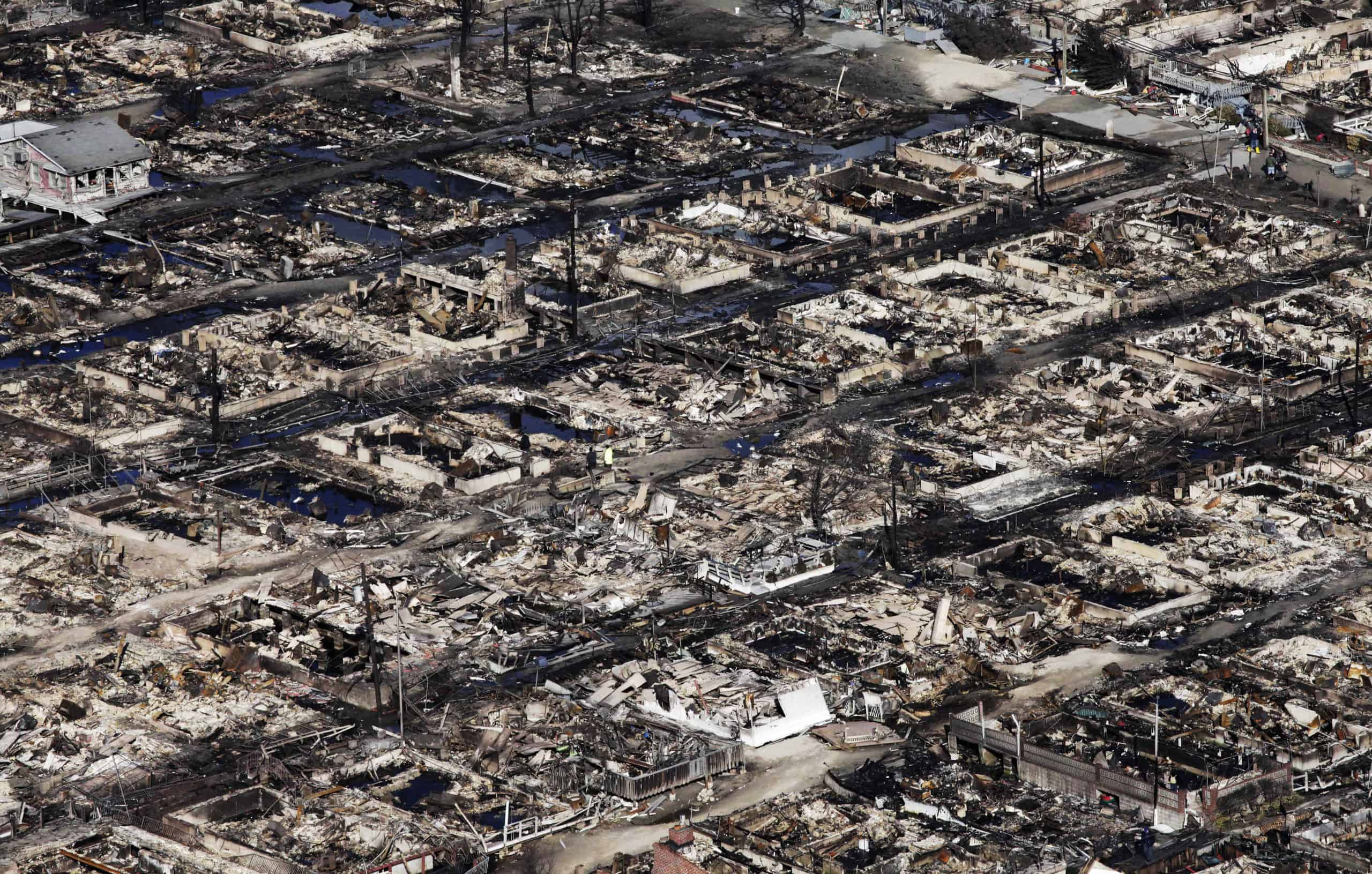
Still, when it comes to building large-scale infrastructure to support adaptation, the United States will probably never replicate the China model. After Hurricane Sandy caused $60 billion in damage in 2012, the Army Corps of Engineers designed proposals for a breakwater in New York harbor. But community groups blocked the effort, even though studies continue to show that much of lower Manhattan and Brooklyn remain highly vulnerable to another storm.
Citing similar cases around the country — from the Houston Ship Canal in Texas to Offutt Air Force Base in Nebraska, home of U.S. Strategic Command — many U.S. climate experts fear that America’s divided politics and failure to coordinate planning across federal, state and local levels are breeding complacency. Security analysts worry that this complacency could hamstring America’s long-term ability to compete in a warming world. China, they say, may end up coming from behind and emerging in a better position to seize strategic, economic and geopolitical gains abroad.
“The campaign to limit systemic risks will shape China’s behavior on a huge range of issues — not just in domestic food and water security, but also issues of access to resources overseas,” says Sikorsky, at the Center for Climate and Security in Washington.
In other words, the race to adapt is intrinsically global, and China’s actions are increasingly having visible effects outside its borders.
“They are looking at untapped resources like cobalt nodules on the seabed in the Central Pacific and protected fisheries in the Arctic,” says Sherri Goodman, secretary general of the International Military Council on Climate & Security and former U.S. deputy undersecretary of defense for environmental policy.
Goodman argues that if China is a “pacing challenge” for the United States — the Pentagon’s language for describing the geopolitical rivalry — then climate is a “shaping threat” because it impacts the entire global environment in which both countries operate and compete. She thinks that “China is ahead of us in understanding how the two are connected.”

China’s success in adaptation is already helping it strike new partnerships with developing countries around the world, such as a satellite project with Ethiopia to monitor climate impacts and agriculture and infrastructure financing in Kiribati. In recent years, dozens of Belt and Road countries have signed agreements to get technical assistance from Chinese engineers and weather data from Chinese sensors.
“China under the leadership of President Xi Jinping has been playing a championing role when it comes to adaptation,” former UN Secretary-General Ban Ki-Moon told the People’s Daily in 2019, urging other countries to study its example.
If poor countries need adaptation help from Beijing today, their interest is unlikely to dissipate in the years ahead. The UN Environment Programme estimates that annual climate adaptation costs in developing countries alone already exceed $70 billion. In higher-emissions scenarios, this figure could rise to $300 billion annually in 2030 and $500 billion in 2050.
As Sikorsky of the Center for Climate and Security told The Wire, “Climate change is intrinsically connected to geopolitics. It’s going to change what nations compete over, and where, and how, all around the world. If you don’t bring an understanding of the climate picture, you’re going to miss things or get things wrong.”
“My assessment is that China’s got 10–15 years on us, in terms of thinking about climate change from a competitive perspective,” says Andrea Cameron of the Naval War College. “I fear we have lost a battle we didn’t even know we were in.”

Eyck Freymann is a contributing writer and a columnist for The Wire. A doctoral candidate in China Studies at Oxford, he is the author of One Belt One Road: Chinese Power Meets the World (November 2020) and Director of Indo-Pacific at Greenmantle, a macroeconomic and geopolitical advisory firm. @eyckfreymann




